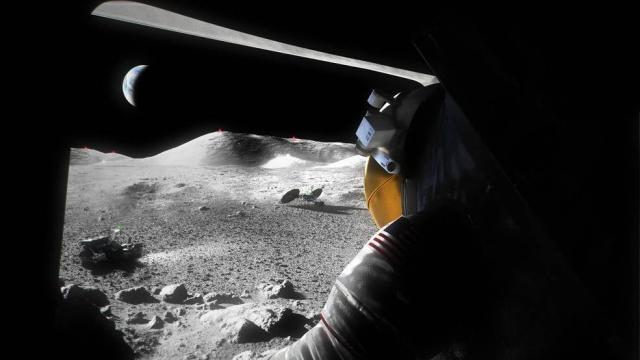NASA has announced plans to develop a second lunar lander for the upcoming Artemis missions to the Moon. The space agency will solicit proposals from U.S. companies, with a target date for delivery within the next four to five years.
Called Sustaining Lunar Development, the second NASA contract to design and build a lunar lander is meant to further the space agency’s goal of establishing long-term operations on and around the Moon. SpaceX is in the process of building a lunar lander, but NASA wants a second option — one with more bells and whistles compared to the first. And by bringing in a second vendor, NASA hopes to reduce costs and foster innovation.
“Today’s announcement is what I said to Congress. I promised competition, so here it is,” Bill Nelson, NASA administrator, told reporters yesterday. “Competition leads to better, more reliable outcomes,” he added. “It benefits everybody. It benefits NASA. It benefits the American people.”
Like the first lunar lander, the second must be capable of delivering astronauts from lunar orbit to the Moon’s surface, but it’ll need to be a bit beefier. The second Human Landing System (HLS) will need to dock with Lunar Gateway — a planned orbital outpost — allow for crew transfers, house a larger crew, and be capable of transporting more stuff to the lunar surface. Said Lisa Watson-Morgan, program manager for the Human Landing System, at the press conference: “We want more cargo, more up-mass, more science.” Like the original contract, the winning bidder must demonstrate one uncrewed and one crewed mission. NASA did not disclose other requirements of the second HLS, aside from these remarks.
NASA intends to issue a draft request for proposals at the end of March and hold an industry day in early April. A final request for proposals, exclusive to U.S. companies, will be issued later this spring, with NASA planning to announce the winning bid early next year. The Sustaining Lunar Development contract means that two companies will compete for future service contracts to the Moon. That said, the second HLS will only apply to later Artemis missions, as SpaceX is the provider for Artemis 3, currently scheduled to happen no earlier than 2025. NASA is eyeing a timeframe of around 2026-2027 to have the second lander available.
SpaceX was awarded a $US2.9 ($4) billion contract to build a lunar lander on April 21, 2021. The Elon Musk-led company will use a Starship vehicle for this purpose. Per its contract, SpaceX must demonstrate the concept during an uncrewed test (currently scheduled for 2024), followed by the crewed Artemis 3 mission, in which NASA intends to send a man and woman to the lunar surface. Watson-Morgan said “everything is going great with the development of the SpaceX lander,” saying the company is reaching its milestones and that the “SpaceX model is improving every day.” Further details weren’t given, despite repeated questions from reporters during the news conference.
That NASA wants a second HLS option is not a big surprise. The space agency originally planned to choose from two of three finalists, SpaceX, Blue Origin, and Dynetics, but budgetary constraints forced NASA to choose just one. For its 2021 budget, NASA requested $US3.4 ($5) billion from Congress to develop multiple Artemis landers, but it received one-fourth of that amount. Blue Origin, led by Amazon founder Jeff Bezos, disagreed with the decision, launching a lawsuit against NASA in a federal court — a case he ultimately lost (Dynetics also sued, unsuccessfully). By virtue of yesterday’s announcement, however, it seems NASA is back on track with its desire to field at least a pair of lunar landers.
Interestingly, SpaceX is not allowed to bid for the Sustaining Lunar Development contract, but it can exercise a provision, known as Option B, in its existing HLS contract. Under this option, SpaceX would “transform” its proposed HLS “into a spacecraft that meets the agency’s requirements for recurring services for a second demonstration mission,” according to a NASA press release. To which the space agency added: “Pursuing more development work under the original contract maximizes NASA’s investment and partnership with SpaceX.” Watson-Morgan said Option B has not yet been exercised by SpaceX, but “we’re planning on working towards that.”
NASA said the request for a second HLS is not a sign that the space agency has lost faith in SpaceX’s ability to build a lander. Jim Free, associate administrator for NASA’s Exploration Systems Development Mission Directorate, said the space agency is “helping American companies to be the first service providers on the Moon,” and that they’re trying to “lower costs through competition,” he told reporters.
Nice words, but it’s not immediately clear to me that a second lander will lower NASA’s costs. The original Blue Origin proposal came with a price tag of $US5.99 ($8) billion, while Dynetics offered a solution costing somewhere between $US8.5 ($12) billion and $US9.5 ($13) billion.
NASA’s intention is to have at least one human landing on the Moon for the span of a decade, said Nelson, and an additional lander will increase the cadence of crewed missions. Each Artemis mission will build on learnings from the previous, which in turn is preparation for the first human mission to Mars in the late 2030s or early 2040s, Nelson said. As Free put it, everything NASA “designs, builds, and procures” for Artemis is done with a “lens towards Mars.”
The value of the Sustaining Lunar Development contract wasn’t disclosed, as that will depend on the upcoming federal budget announcement. Nelson said he’s confident that the required funds will be made available. “We’re expecting to have both Congress support and that of the Biden administration,” he said, and “we’re expecting to get this competition started in the fiscal year 2023 budget.”
